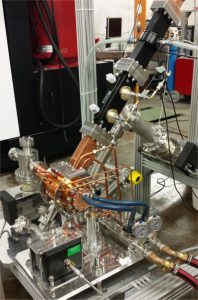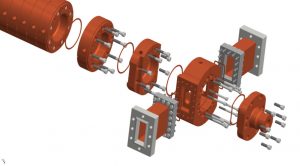
LINACS (linear accelerators) are metallic structures powered by radio-frequency systems that allow to accelerate particle beams. They can be used in several fields of both research and industry such as injectors for light sources or colliders, free electron lasers-FELs, particle sources for experiments on fixed target, X-ray sources for radiotherapy or medical diagnostics, national security systems and material treatments.
These structures can reach lengths of several meters and operate under high and ultra-high vacuum conditions.
For their realization brazing techniques are generally adopted using special furnaces that only few companies (or laboratories) have and are, therefore, very expensive. If we consider accelerating structures of few meters, the number of those companies is reduced to few units in the world. Furthermore, brazing procedures show a not negligible risk of failure and the metallic materials, annealed at 800-1000 degrees, become, at the end of the process, very soft and mechanically less resistant. In addition, from high power test results, it turns out that the annealing process can lead to discharge phenomena and slow down the conditioning procedures compared to not annealed materials.
To overcome all these problems, a new fabrication technique has been conceived and patented at National Laboratory of Frascati. It is based on the use of special metallic gaskets that avoid all brazing procedures.

The idea has been successfully tested on two structures used for generation and first acceleration of electrons (guns). With the BOLT project, financed by INFN in the framework of Technology Transfer, with the LNF researcher David Alesini as PI, we will be built the first prototype of a complex accelerating structure. This fundamental test will allow to demonstrate that this technique can be applied for the realization of any type of accelerating structure.
The simple fabrication process its lower cost and the potentially better performances that can be achieved with this new technology, will open the market of accelerators to a greater number of manufacturing companies with a potentially significant impact on the LINAC market.
Translation by Camilla Paola Maglione, Communications Office INFN-LNF
 INFN-LNF Laboratori Nazionali di Frascati
INFN-LNF Laboratori Nazionali di Frascati